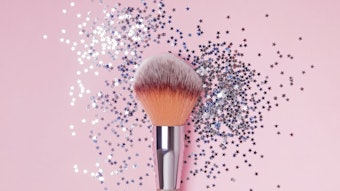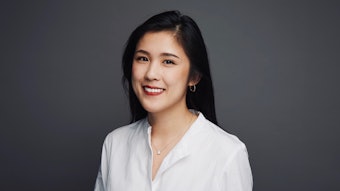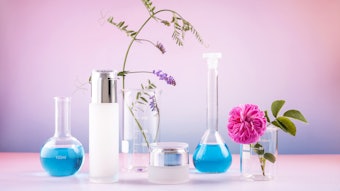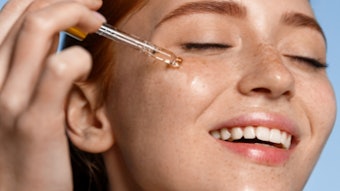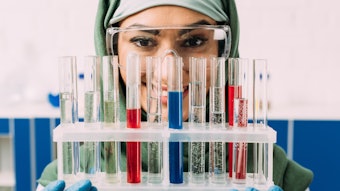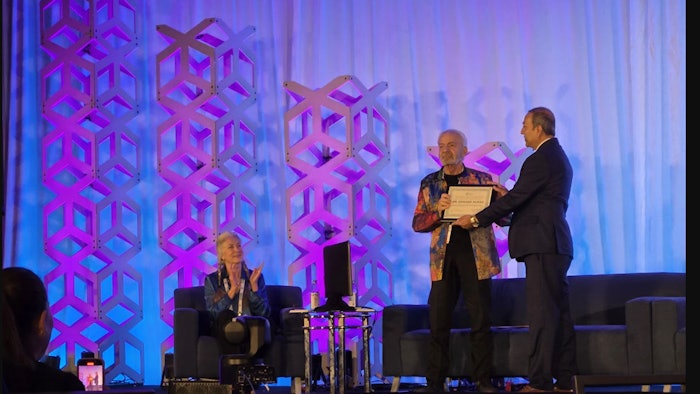
Beauty and skin care from top to bottom — i.e., hair and scalp care, to intimate care and anal sexual health — led the conference sessions on day two of the Society of Cosmetic Chemists' (SCC's) 78th Annual Scientific Meeting and Technology Showcase, held Dec. 11-13, 2024, in L.A. Notably, the intimate care session was the first-ever dedicated to the subject. The marquee keynote opening the day's sessions, however, was the esteemed Frontiers of Science lecturer Howard Murad , M.D., who presented on water as the key to aging.
The awards luncheon highlighted five individuals who have dedicated their time to advancing cosmetic science, following which the new 2024-2025 SCC executive board members were announced. After a break for the exhibition, sessions reconvened to discuss skin health science and the revolution for artificial intelligence (AI) in beauty. The day wrapped up with dinner and drinks in the exhibition. Following are some highlights.
Skin Water Loss, Cultural Stress and Neuroceuticals
Caryn Weiss, of Amway, and Paul Lawrence, Ph.D., of BioCogent welcomed the Frontiers of Science award lecture moderator Leslee Goodman, founder and principal at Alchemy On Demand, who led the discussion with Murad. Pure Murad, there is evidence that cellular water loss, or hypohydration, is the underlying cause of the degenerative diseases associated with aging. Intracellular water loss eventually disables the cell’s ability to function as intended, which is compounded by lifestyle and daily stress, resulting in inflammaging. Inflammaging wreaks further havoc, damaging cell membranes, inducing excess cortisol, breaking down collagen and more.
While cosmetic scientists have begun to address these effects with retinol and nutricosmetics, Murad sees the underlying issue being dehydration. "We need to understand a simple concept: don't allow water to escape [from our body] anymore." He added that key to this are materials that affect fluids and thicken cell membranes, such as:
- osmolytes,
- betaine,
- aquaporins,
- taurine and
- lecithin and other compounds to strengthen skin.
Furthermore, the "cultural stress" to which we subject ourselves daily never gives the body a chance to heal. The pituitary gland releases cortisol that sets enzymes into action that degrade collagen. In turn, collagen break down contributes to cellular water loss, and subsequent aging.
Per Murad, neuroceuticals, i.e., products derived from certain foods, can reduce stress and bypass the need to see a psychiatrist. Additional breakthroughs he sees moving forward include: healing topicals to better penetrate the skin cells, speed skin repair, reverse hair loss, rebuild skin elasticity and even treat cancer and other diseases. Furthermore, he sees corrective cosmetics that actually correct wrinkles, sagging skin and hyperpigmentation, as well as those that soothe overstimulated nervous systems to restore a sense of well-being.
Lastly, Murad announced, for the first time, the establishment of the Dr. Howard Murad Inclusive Wellness Program, which will launch at the Long Island University Pharmacy School in 2025.
Hair and Scalp Health: Mildness, Sensitivity, Imbalances and Ultrafine Structure of the Hair Surface
Reducing irritation potential: The hair and scalp session featured Sarah de Szalay as moderater and started off with Andrew Robertson, of Nouryon, who described a study examining the ability of a naturally derived and readily biodegradable polymeric surfactant to increase the micelle size of conventional surfactants. This, in turn, creates a system with lower skin irritation potential.
AI-driven peptide discovery to improve sensitive scalp: Philip Ludwig, of BASF, sought to improve sensitive scalp for individuals with textured hair by using AI. Combining predictions of machine learning with in vitro tests, the company evaluated trillions of peptides and built a predicted architecture to identify and unlock anti-inflammatory peptides from rice protein. In vitro assays showed that the peptides inhibited TNF-α release from macrophages. Under TNF stress, the unlocked peptide solution increased filaggrin in reconstructed epidermis. In vivo, it significantly reduced sensitive scalp (redness) vs. the placebo and significantly improved scalp hydration (vs D0).
Bacterione, mycobiome in scalp irritation: Susan Sperring, of Symrise, Inc., explored the effects of imbalances in common scalp disorders, in particularly looking closely at the bacteriome as well as the mycobiome. The role that sebum plays in scalp discomfort and common scalp disorders such as dandruff, seborrheic eczema , atopic scalp and general irritation also was examined.
Ultrafine mapping of hair surface, integrity: Finally, Guojin Zhang, Ph.D., of Croda, Inc., focused in on the ultrafine structure of hair’s surface via quantitative nanomechanical property mapping. High resolution images of modulus, adhesion and energy dissipation were captured, uncovering unique nano-domain structures based on nanomechanical properties: soft hydrophobic domains with low modulus are interconnected by more rigid hydrophilic boundaries with high modulus. A comparative analysis of virgin, bleached and UV-irradiated hair also revealed various forms of nanoscale damage in cuticle regions. Per Zhang, these findings significantly advance the understanding of the ultrafine structural integrity of hair surfaces, particularly in relation to the effects of environmental and chemical treatments at the nanoscale.
Intimate Care: Personal Lubricants, Whole-body Deodorant and Anal Sexual Wellness
 The SCC program introduced, for the first time ever, a session on intimate wellness.
The SCC program introduced, for the first time ever, a session on intimate wellness.
Growing intimate care market: Gabriella Baki, Ph.D., of the University of Toledo, moderated the concurrent session on intimate care – an all-new session focus for the meeting this year. She welcomed the first presenter, Lois Lu of Bloomage Biotechnology USA, who described the growing intimate wellness market, as well as increasing comfort especially on social media in terms of discussions around it. She also provided examples of successful products on the market.
"Many consumers are paying attention to active ingredients in intimate care," she said, noting examples for hydration and dryness. Per Lu, the main trends are currently:
- herbal extracts,
- pre/probiotics and
- NMF/HA/glycerin.
Personal lubricant safety, regulation: Jacob Sessions, of Überlube, Inc., took a hard look at the regulation of personal lubricants as medical devices and safety considerations. Per Sessions' presentation abstract, lubricants are classified as a class II medical device by the U.S. Food and Drug Administration (FDA) and a class IIb in the EU; such regulatory hurdles create a substantial barrier to developing personal lubricants. In terms of proving the efficacy and safety of these ingredients, interestingly, the U.S. looks at the contact duration of use, while the EU considers the contact of duration of residuals.
The main types of lubricants, per Sessions, include: aqueous-based, lipid-based, silicone-based and mixtures. He additionally described how lubricants work and ways to measure them. "Lubricants prevent contact between surfaces," he explained, highlighting factors including rheology and tribology; the latter being measured by a tribometer or texture analyzer. He also explained the difference in pH between the vagina and rectum, noting the importance of this when formulating or using these products. Additional considerations included osmolality, condom compatibility and the fact that any water-based lube must be preserved, especially considering its internal use. His take-away message was, "give sincere consideration to what it takes to make a safe lube."
Whole body deodorant testing: Nalini Kaul, Ph.D., of Princeton Consumer Research, described whole-body deodorant efficacy and safety testing, and product acceptability. She provided a review of the sweat glands, including eccrine (all over the body) versus apocrine (in focused areas, especially hair follicles, and occurring around puberty). She additionally outlined how microbes are the cause of malodor in the axilla but noted that microbial malodor in the genital area has been studied very little. Interestingly, Kaul shared that individuals of East Asian descent tend to have a gene mutation that reduces the production of malodor, compared with European and African counterparts.
She then provided a case study outlining how a whole-body deodorant was tested for efficacy in a randomized, blinded sensorial clinical trial. Odor qualification was made by expert judges and safety included visual assessments and AE collection. The results indicated product efficacy in combatting malodor from axilla, feet and genitals (p < 0.05).
Anal sexual wellness: Finally, Greg Lam, of Future Method, Bespoke Surgical, presented on one of the final frontiers in the sexual health and wellness industry: anal sex. "We will explore the crucial role of proper lubrication and skin care in ensuring safe and pleasurable anal sex," his presentation abstract states. Lam addressed everything from the necessity of lubrication for anal intercourse, to the types of lubricants best-suited for anal sex and the role of skin moisturization in maintaining the integrity of sensitive tissue.
In addition, Lam discussed the anatomy of the anus, including the buttocks, sphincter (rim of the anus) and internal sphincter and anal canal, and shared some common practices that can damage these areas; such as:
- sitting on the toilet for too long, straining (which can cause tears);
- using wet wipes, which can cause irritation and "swamp ass" when it leaves the area wet - another reason why preservatives are essential; and
- lack of hygiene (i.e., residual lubes, physical activity/sweat, hormones and tight clothing), which can cause butt-ne (butt acne).
In addition, he described anal lubes that were unsafe for consumers:
- warming and cooling lubes, which were not designed for anal play and will irritate the rectum;
- desensitizing lubes, which can dull or remove pain altogether, which masks potential injuries;
- silicone lubes when using toys, because like-dissolves like and silicone lube can warp silicone toys; and
- high osmolality lubes; per Lam, several papers suggest lubricants with high osmolality (due to glycols) can cause vaginal and anal epithelial damage.
In wrapping up the session, Baki stated, "I'm glad to see the SCC has opened up this new session to discuss the things we don't usually talk about."
Awards Luncheon: Advancing Cosmetic Science
Following the morning sessions, the awards luncheon highlighted five esteemed individuals who have dedicated their time to advancing cosmetic science. These included:
- Irwin Palefsky, of Cosmetech Labs, was honored with the highest award: The Maison G. deNavarre Medal Award;
- Cathy Anglin received the SCC Merit Award;
- Krupa Koestline was presented the Florence Wall Women in Cosmetic Chemistry Award;
- Randall Wickett, Ph.D., was honored with the Robert A. Kramer Lifetime Service Award; and
- Paul Lawrence, Ph.D., was honored with the society's first-ever SCC Education Award.
 Members of the 2024-2025 SCC Praesidium
Members of the 2024-2025 SCC Praesidium
Members of the new SCC executive board then took the stages, including: Akshay Talati, Pharm.D., goop, president; Marisa Plescia, Bell International Labs, vice president; Giorgio Dell'Acqua, Nutrafol, secretary; Amy Marshall, BYK Additives, Area I director; Caryn Weiss, Amway, Area II director; Cynthia Johnson, Cindy J Cosmetic Labs, Area IV director; Dorothy Maraprossians, Azelis Canada, Area V director; and Tony O'Lenick, Jr., Nascent, immediate past president.
Skin Health Science: Hypodermis Target, Marine Megasugar for Wellness/Anti-aging, Schisandra Pro-Longevity, Cell Surface Glycosylation, Neuro-Immuno-Cutaneous Treatment for Sensitive Skin
Hypodermis "missing link" and anti-aging active: In the skin health science session, moderated by Liyuan Ji, Krys Bojanowski, Ph.D., of Sunny BioDiscovery, Inc., highlighted the hypodermis as a "missing link" in anti-aging strategies. According to Bojanowski, the hypodermis is a major structural component of the skin responsible for the youthful plumpness of the face and hands. "We need to include the hypodermis in our anti-aging strategies," he stated, additionally describing an active ingredient, SBD.5HC, with a levan-based carrier to penetrate deeply into skin. He demonstrated its effects on adipocyte progenitor cells to support skin structure.
His take-home messages were:
- The hypodermis provides physical plumpness, biochemical (adipokines) and reconstructive (stem cells) support for the upper layers of skin;
- Hypodermal decline is considered an early initiation event in skin aging; and
- Hypodermis-targeting compounds combined with deep-penetrating carriers are essential to an effective anti-aging strategy.
Megasugar anti-aging via wellness: Richard Leroux, Ph.D., from Seqens Personal Care, introduced a marine biotech “megasugar” to improve skin appearance and activate "well-being and happiness" signaling pathways. Per the presentation abstract, in his work, G278, an exopolysaccharide (EPS) obtained from a micro-organism biofermentation, was examined through different techniques: in vivo versus placebo on volunteers measuring skin condition quality (moisturization, texture), but also emotional parameters with a mirror test, ex vivo using proteomic studies and in vitro thanks to a specific keratinocyte-sensory neurons culture.
"Dopamine on skin can reduce inflammation, in turn improving the skin barrier," he explained, highlighting how being in a good mood impacts appearance. However, he added that a bad mood can do the opposite, triggering cortisol that degrades the quality of skin. His work interestingly incorporated voice loudness and frequency measurements in subjects' responses to themselves in the mirror as a biometric to assess happiness. Per Leroux, people were more positive after regular application of the megasugar.
Skin healthspan, natural active to target hallmarks: Christophe Toumit, of Greentech, looked to characteristics of supercentenarians' skin for answers to longevity. He noted that two longevity genes, in particular, are overly-expressed by these individuals: SIRT6 and FOXO3, which especially aid in cellular detox and autophagy. He presented the multifunctional activity of a Schisandra chinensis berries (aka magnolia berries)-based active (SChE) to act on longevity hallmarks to extend skin healthspan.
In particular, the ingredient increased longevity gene expression, autophagy and mitochondrial markers. In stressed 3D models, it restored the skin barrier and reduced oxidation and inflammation, per the presentation abstract. Clinically vs. placebo on multi-ethnic panels, SchE significantly increased skin microcirculation, elasticity and brightness, and prevented wrinkles.
 Fred Zuelli, Ph.D., of Mibelle Biochemistry, presents his concept of cell membrane glycosylation as a novel target for anti-aging.
Fred Zuelli, Ph.D., of Mibelle Biochemistry, presents his concept of cell membrane glycosylation as a novel target for anti-aging.
Cell surface glycosylation - a new target: Fred Zuelli, Ph.D., of Mibelle AG, explored cell surface glycosylation of epidermal stem cells as new target for cosmetic research. As Zuelli explained, per the presentation abstract, cell surfaces are covered by the glycocalyx, a sugar coat composed of complex carbohydrates (glycans) on membrane lipids and proteins. Due to their prominent location at the outermost surface of the cell, they participate in many cellular processes, such as cell-cell communication, cell adhesion and differentiation.
Mibelle Biochemistry examined the glycosylation profiles of young and aged epidermal stem cells using a lectin array, which revealed major changes. A plant stem cell extract was additionally identified to rejuvenate the glycan profile of aged stem cells, thus potentially protecting skin stem cells from aging. The analysis of skin cells' glycosylation patterns could also potentially be used to develop a skin aging clock, per Zuelli.
"Glycosylation affects six of the hallmarks of aging," Zuelli noted. These include: loss of proteostasis, cellular senescence, altered intercellular communication, deregulated nutrient sensing, immune response and stem cell exhaustion. He added that treatment with the active rejuvenated cell surface glycosylation to its original state.
Neuro-immuno-cutaneous treatment for sensitive skin: Lastly, Melissa Bergman, of Solabia Group, suggested harnessing the neuro-immuno-cutaneous system to treat sensitive skin. Per Bergman, researchers used a co-culture model of keratinocytes and dendritic cells under inflammatory condition to study the release of pro resolving lipid mediators. "We then used sodium lauryl sulfate (SLS)... to induce irritation and erythema in volunteers to study the restoration of skin barrier function and the redness reduction," the presentation abstract states. Researchers evaluated the soothing effect on human re-innervated skin explants stressed with lactic acid, but also on the face of volunteers having dry sensitive skin and prone to scratching in winter, by measuring electrodermal response reflecting skin sensitivity by using a polygraph.
AI Beauty Revolution: Benchmarking, Precision Prebiotics, Screening Antioxidants, Applying Synthetics Intel to Naturals, Integrated Platform for Multiple Biological Assays
Finally, the concurrent AI-themed session, sponsored by Uncountable, was moderated by Angela Eppler, Ph.D., and kicked off with a talk by Yahya Syed, of Potion AI. He described how to apply AI to product benchmarking. Jaide Jensen, from Arcaea, discussed precision prebiotics developed via AI to modulate the skin microbiome for cosmetic benefits. Haidong Liu, Ph.D., of Schrödinger, highlighted AI to screen antioxidants using machine learning and physics-based modeling, while Lun Yu, Ph.D., of MetaNovas Biotech, explained a deep learning approach to transfer knowledge from synthetic to natural compounds.
Finally, Hang Ma, Ph.D., of the University of Rhode Island, demonstrated a multifaceted platform integrating biological assays, proteomic analyses, network pharmacology, machine learning and target binding techniques for the discovery of natural skin protectants. In particular, his work focused on using AI to find the biomarkers to test for ferroptosis activities. He noted, "we don't rely on proteomics data, we generate it in house.
Day two wrapped up with a cocktail reception and dinner in the exhibit area. Stay tuned as we roll into the third and final day of the SCC78 Annual Meeting and Technology Showcase.
 Attendees worked their way through a bustling room of tabletop exhibitors.
Attendees worked their way through a bustling room of tabletop exhibitors.


